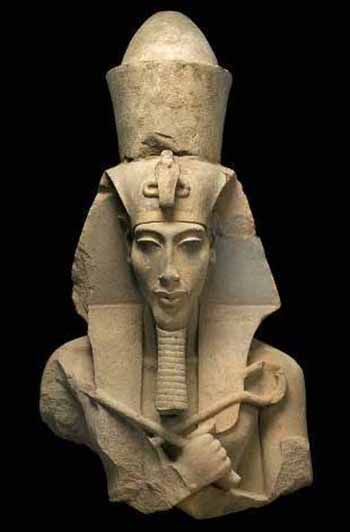
Predynastic Period (5500 - 3100 BC)
In the Predynastic Period of Ancient Egypt, people evolved from hunters and gatherers using stone weapons into an organized central society.
Animals such as donkeys are tamed and used in daily life, not just for food. Egyptians trace their roots back to a land they called Punt. At first, Egypt is ruled by many kings, each one fighting with others to try to take over and rule more kingdoms.

Early Dynastic Period (2920 - 2650 BC)
Ancient writing came about during the Early Dynastic period in the form of hieroglyphs. By the end of the Early Dynastic period, Egypt will be unified into one kingdom and ruled by a pharaoh.The Early Dynastic period consists of dynasties 0 through 2 usually, and lasted about 300 years. There were at least 30 kings during the Early Dynastic period and some of the first monuments and temples were built at Saqqara and Abydos during this time.
 Old Kingdom (2650 - 2152 BC)
Old Kingdom (2650 - 2152 BC)The Old Kingdom contained the 3rd through the 6th Dynasties, or about 500 years of rule. The capital was in Northern Egypt, in Memphis, and the rule was held solidly by the pharaohs. During this time, some pharaohs were even considered to be gods, and were worshipped as religious figures. The first pyramids were built as step pyramids of mud bricks early in the Old Kingdom period. The true pyramids were later constructed of stone blocks, forming the ancient monuments that we still study today. Ancient doctors knew quite a lot about the body, antiseptics and surgery. Artists were showing great talent in painting, carving and sculpting.
 First Intermediate Period (2150 - 1986 BC)
First Intermediate Period (2150 - 1986 BC)
All of the successes of the Old Kingdom began to fall apart during the First Intermediate Period. The Nile River was flooding, causing trouble for those living off of the land there. Crops were either being washed out from the floods, or not getting any water at all due to issues with irrigation. There was widespread hunger and death. The pharaoh had lost control of the lands to the local governments, some of which were corrupt.
 Middle Kingdom - (1986 - 1759 BC)
Middle Kingdom - (1986 - 1759 BC)
Intef and Mentuhotep from Luxor were able to reunite the broken lands under local rule into rule by one king again. This began the 11th Dynasty. While the pharaoh never really regained power over the local governments, foreign trade started to happen again. Irrigation projects were fixed and completed. In fact, it could be dangerous to be the pharaoh. One of the Middle Kingdom kings was killed by a group of local governors who wanted to keep their power. It was well into the Middle Kingdom before power was restored to the pharaoh. Egyptians enjoyed wealth again, and the population began to grow.
 Second Intermediate Period (1759 - 1539 BC)
Second Intermediate Period (1759 - 1539 BC)Immigration of people who weren't born as Egyptians eventually led to the Second Intermediate Period. These people moved to Egypt from their countries and set up towns and communities which followed their own rules. They did not live by the Egyptian laws, nor did they recognize the rule of the pharaoh. During the Second Intermediate Period, Egypt was ruled by a string of foreign kings. Amosis, a military general, set off wars against these foreigners and the foreign rule, and eventually put Egypt back under Egyptian control, starting up the 18th Dynasty.
 New Kingdom (1539 - 1069 BC)
New Kingdom (1539 - 1069 BC)
After the Second Intermediate Period, the kings of the 18th Dynasty vowed that they would never want to see Egypt under a foreign king again. The kings of the 18th Dynasty were fierce military generals, fighting to keep Egypt ruled by Egyptians. They fortified the Egyptian borders to ward against foreign attacks. Egypt became wealthy and powerful again, and the kings taxed all foreigners and foreign trade heavily. Foreigners were treated badly.As the 19th Dynasty started, Egypt began to fail again. Foreign relations were not good, and the foreign rulers were waging war on Egypt. The strongest king of the time was Ramses II, but after his death there were many weak kings, pushing Egypt back into political chaos and disorder.
 Third Intermediate Period (1070 - 657 BC)
Third Intermediate Period (1070 - 657 BC)Upon the death of Ramses XI, a man from Tanis named Smendes assumed the throne of Egypt. No one was really in charge at this point, and there was much chaos and confusion. The 22nd Dynasty was made up of Chiefs from Libya, and they ruled at the same time as the pharaohs of the 23rd Dynasty. This political strife lasted for several hundred years.

Late Kingdom - (664 - 332 BC)
Egypt was invaded by Nubia, as the southern Nubians rushed the northern Egyptians. The Nubians won, and for a short while began to restore old Egyptian traditions and religious practices. It was not long before the Assyrians conquered the Nubians.An Egyptian leader was put on the throne and the 26th Dynasty began.Peace came about by the second or third generation of kings, but Egypt never returned to the power and glory that it once had. Egypt was then conquered by Persia, and the Egyptians suffered badly.During this time the Greeks conquered Persia, and the rule of Egypt passed to Greece. Alexander the Great was welcomed into Egypt and recognized as the liberator of Egypt from Persian rule. It would be 2000 years before another Egyptian would hold the throne of Egypt again, in the 18th Century AD.




































